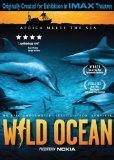Wild Ocean was originally designed as a 3D IMAX experience. Though the production has been pared down to a humbler 2D widescreen, it still is effective as a well-made film that documents the Sardine Run in South Africa, where the migration of millions of Sardines makes for both feeding frenzies of ocean predators, and a wild festival of fishing for various townspeople.
The motivation behind the making of this film was the awe inspiring image of a “bait ball,” which is essentially an undersea tornado of fish that move as if they had one conscience. This amorphous assembly of small fish looks like oil spills from the sky and is attacked relentlessly by various birds, dolphins, sharks, and other sea predators. Indeed, seeing this once a year phenomenon that is Northbound off the South African coasts is majestic to behold. I can only imagine how intense it would be on a full-blown IMAX screen, but on any screen it is still quite the sight.
Aside from the ‘bait ball’ that the directors discovered while scuba diving before making this film, they capture all sorts of wonderful moments of animals in nature and the people who are a part of the annual harvest of Sardines. Much of this film is quite captivating, be it seeing the efforts of those tending to the enormous fishing nets or seeing birds dive from 100 ft. in the sky, piercing the water like strange bullets and diving 30 ft. down to catch fish. A barrage of these birds looks as if the helicopter filming them is in fact firing a very large gun at the ocean, another site I wish I could have seen on the IMAX screen.
There is an environmental message that seems a touch tacked onto the film as it does not fit the initial narrative. The message promotes the idea of Oceanic reserves for animals (which South Africa did get, it should be noted, after the film and certainly is a great idea). The reason the message may seem tacked on is how so much time was spent speaking about the long-standing traditions of the South African people, some going back hundreds of thousands of years, and then the end of the film confuses this by emphasising a need for “change.” The message has its place in the film and is certainly a very sensible one (its made all the more clear in the special features) but disrupts what was a fluid narration until that point. Really though, its not that disturbing, just the one lone nit-pick I have with this film.
Video
Widescreen 16:9. Since it was designed for such an enormous screen, naturally one would assume that the picture quality would not lose anything being condensed, and they would be correct; the picture quality is indeed very nice. The depths of the ocean appear dark but not so shadowy that we lose all movement of the animals as they swirl around at intense speeds.
Audio
Dolby Digital 5.1 Surround sound is available in English, French and Spanish. The score can be quite booming, always rhythmic (which is not surprising at all considering the makers are also the creators of STOMP) and hardly lets up throughout the 40 minute duration. The surround sound keeps the audience involved throughout but there are times when the squeaks of the dolphins or cackling of birds can overrun the speakers to the point where it is headache inducing. It is one thing to have sounds dance around the various speakers, but sometimes audience immersion sacrifices comfort when dealing with animals whose voices are less than melodic. I had a sense of dread when the camera approached an island of seals…mercifully it stayed clear and cut back to shots of fish where all we hear are calming waves of water.
Special Features
There is a very hearty amount of features for a single disc DVD. This may be to compensate for the lack of 3D or unavoidable conversion from IMAX to a regular sized screen.
Interview with Directors: About 15 minutes of Luke Cresswel and Steve McNicholas explaining how the film came about and other assorted details. A non-pretentious interview that offers facts I was actually interested in hearing.
Behind the Scenes:
– Recording Wild Ocean: a quick look at the scoring of the film with a small chamber orchestra in a studio.
– Shooting the Ocean: A glimpse at the preperation and process of those operation the enormous IMAX/3D camera.
Trailers: Explains itself I think.
Who, What & Where: Written facts about the subjects within the film.
Film Trivia Quiz: Another that is self-explanatory.
Final Thoughts
Great care went into the making of this film and in the conversion to DVD from IMAX (what can be a very humbling task), and for that the adventure is certainly worth it. It is a short piece, so there is not much excuse avoiding it if you are able to get your hands on it for at least a single viewing.





